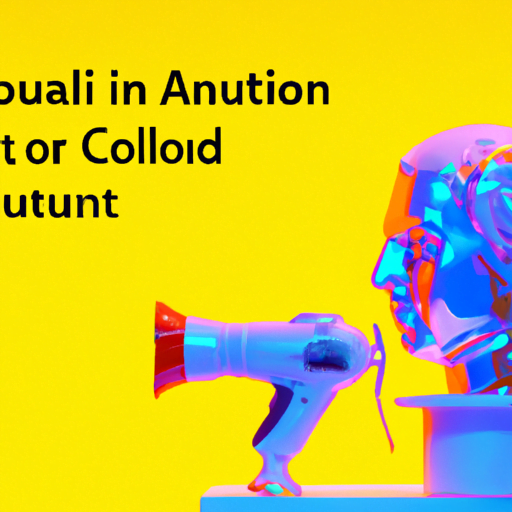
-
Table of Contents
- The Future of Creative Collaboration: Human-AI Partnerships
- The Rise of AI in Creative Collaboration
- Benefits of Human-AI Partnerships
- Real-World Examples
- 1. The Next Rembrandt
- 2. Jukedeck
- 3. Adobe Sensei
- Challenges and Ethical Considerations
- 1. Bias and Fairness
- 2. Intellectual Property
- 3. Human Creativity and Autonomy
- The Future Outlook
- Summary
The Future of Creative Collaboration: Human-AI Partnerships

In recent years, the rapid advancement of artificial intelligence (AI) has sparked both excitement and concern about its potential impact on various industries. One area that has been particularly affected is creative collaboration. As AI technologies continue to evolve, they are increasingly being integrated into creative processes, leading to new possibilities and challenges. This article explores the future of creative collaboration and the emerging trend of human-AI partnerships.
The Rise of AI in Creative Collaboration
AI has already made significant inroads into creative fields such as music, art, and design. For example, AI algorithms can compose music, generate artwork, and even design products. These advancements have raised questions about the role of human creativity in a world where machines can replicate or even surpass human capabilities.
However, rather than replacing human creativity, AI has the potential to enhance it. By leveraging AI tools, creatives can streamline their workflows, access vast amounts of data and insights, and explore new possibilities. AI can act as a collaborator, providing suggestions, generating ideas, and assisting in the creative process.
Benefits of Human-AI Partnerships
1. Enhanced Creativity: AI can augment human creativity by providing novel perspectives, generating ideas, and offering alternative solutions. By working together with AI, creatives can push the boundaries of their own imagination and explore uncharted territories.
2. Increased Efficiency: AI can automate repetitive and time-consuming tasks, allowing creatives to focus on higher-level thinking and problem-solving. This can lead to increased productivity and faster turnaround times.
3. Access to Data and Insights: AI can analyze vast amounts of data and extract valuable insights that humans may overlook. By leveraging AI’s data processing capabilities, creatives can make more informed decisions and create content that resonates with their target audience.
4. Collaboration at Scale: AI can facilitate collaboration on a global scale. With AI-powered platforms, creatives from different parts of the world can connect, share ideas, and work together seamlessly. This opens up new opportunities for cross-cultural collaboration and diverse perspectives.
Real-World Examples
Several real-world examples demonstrate the potential of human-AI partnerships in creative collaboration:
1. The Next Rembrandt
In 2016, a team of data scientists and art historians collaborated to create a new Rembrandt painting using AI. By analyzing Rembrandt’s existing works, the team trained an AI algorithm to generate a new painting in the style of the Dutch master. The result was a stunning artwork that captured the essence of Rembrandt’s style while being entirely AI-generated.
2. Jukedeck
Jukedeck is an AI-powered music composition platform that allows users to generate royalty-free music for their creative projects. By inputting parameters such as genre, tempo, and mood, users can have AI compose original music tailored to their specific needs. This tool empowers creatives to access high-quality music without the need for extensive musical knowledge or expensive licensing fees.
3. Adobe Sensei
Adobe Sensei is an AI-powered platform integrated into Adobe’s creative suite of tools. It offers features such as content-aware fill, automated image tagging, and intelligent font matching. These AI capabilities assist creatives in tasks such as image editing, graphic design, and font selection, saving time and enhancing the overall creative process.
Challenges and Ethical Considerations
While human-AI partnerships offer numerous benefits, they also raise important challenges and ethical considerations:
1. Bias and Fairness
AI algorithms are only as good as the data they are trained on. If the training data is biased or lacks diversity, the AI system may perpetuate and amplify existing biases. It is crucial to ensure that AI systems are trained on diverse and representative datasets to avoid reinforcing societal inequalities.
2. Intellectual Property
When AI is involved in the creative process, questions arise regarding intellectual property rights. Who owns the output generated by AI? Is it the human collaborator, the AI system, or a combination of both? Clear guidelines and legal frameworks need to be established to address these issues and protect the rights of all parties involved.
3. Human Creativity and Autonomy
As AI becomes more capable of generating creative content, there is a concern that human creativity may be undervalued or diminished. It is essential to recognize and celebrate the unique qualities of human creativity while leveraging AI as a tool for inspiration and collaboration.
The Future Outlook
The future of creative collaboration lies in the synergy between humans and AI. As AI technologies continue to advance, they will become more integrated into creative workflows, enabling new forms of collaboration and innovation. The key to harnessing the full potential of human-AI partnerships lies in addressing the challenges and ethical considerations associated with these collaborations.
By fostering a culture of responsible AI use, promoting diversity in training data, and establishing clear guidelines for intellectual property rights, we can create a future where human creativity and AI capabilities coexist harmoniously.
Summary
The future of creative collaboration is evolving with the rise of AI. Rather than replacing human creativity, AI has the potential to enhance it by providing new perspectives, increasing efficiency, and facilitating collaboration at scale. Real-world examples such as The Next Rembrandt, Jukedeck, and Adobe Sensei demonstrate the power of human-AI partnerships in various creative fields.
However, challenges and ethical considerations must be addressed. Bias and fairness, intellectual property rights, and the preservation of human creativity and autonomy are crucial areas to focus on. By navigating these challenges and embracing responsible AI use, we can unlock the full potential of human-AI partnerships and shape a future where creativity flourishes with the assistance of AI.
